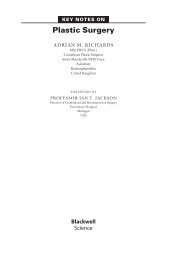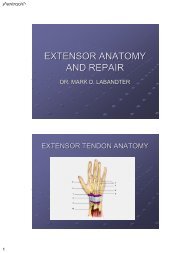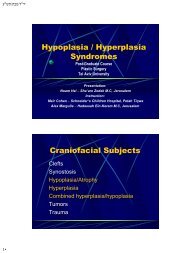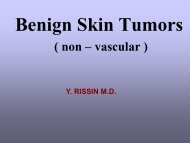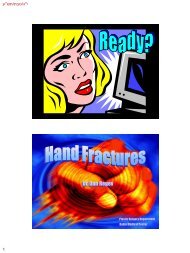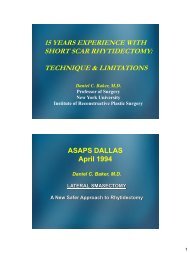ALLOPLASTIC MATERIALS IN PLASTIC SURGERY
ALLOPLASTIC MATERIALS IN PLASTIC SURGERY
ALLOPLASTIC MATERIALS IN PLASTIC SURGERY
Create successful ePaper yourself
Turn your PDF publications into a flip-book with our unique Google optimized e-Paper software.
ע"<br />
שת/<br />
תבט/<br />
ד"<br />
י<br />
1<br />
<strong>ALLO<strong>PLASTIC</strong></strong> <strong>MATERIALS</strong><br />
<strong>IN</strong> <strong>PLASTIC</strong> <strong>SURGERY</strong><br />
David Leshem M.D.<br />
DEPARTMENT OF <strong>PLASTIC</strong> <strong>SURGERY</strong><br />
TEL AVIV SOURASKY MEDICAL CENTER<br />
January 2001<br />
ALLOPLASTS – DEF<strong>IN</strong>ITIONS<br />
• Foreign, non-autogenous materials implanted into tissues for purpose of<br />
augmenting, reconstructing or replacing tissues, organs or functions of the<br />
body.<br />
• Does not depend on local tissues for survival.<br />
• Temporary implants must disintegrate gradually within a predictable time<br />
without the production of non-compatable, harmful disintegration products.<br />
• Permanent implants must provide maintenance-free function in a<br />
physiologic environment over the patient’s lifetime.<br />
• Advantageous because: 1. No donor site morbidity.<br />
2.Unlimited availability.<br />
3.No operative time for harvesting the graft.
ע"<br />
שת/<br />
תבט/<br />
ד"<br />
י<br />
2<br />
Criteria for the IDEAL ALLOPLAST (Scales)<br />
1. Not physically modified by soft tissue.<br />
2. Chemically inert.<br />
3. Elicits no inflammatory or foreign body reaction.<br />
4. Non-carcinogenic.<br />
5. Produces no state of allergy or hypersensitivity.<br />
6. Resists mechanical strains.<br />
7. Capable of fabrication in the form desired.<br />
8. Sterilizable.<br />
9. Effective in its intended application.<br />
10. Temporary (degradable) implants must resorbe in<br />
predictable non-toxic fashion.<br />
Biocompatibility (Williams)<br />
“A state of affairs when a biomaterial exists<br />
within a physiologic environment without<br />
either the material adversely and<br />
significantly affecting the body, or the<br />
environment of the body adversely and<br />
significantly affecting the material.”
ע"<br />
שת/<br />
תבט/<br />
ד"<br />
י<br />
3<br />
Mechanical properties<br />
Mechanical properties<br />
• Elastic: X-Y<br />
• Plastic: Y-F<br />
• D: Permanent deformation<br />
• U: Ultimate strength<br />
• F: Ultimate failure
ע"<br />
שת/<br />
תבט/<br />
ד"<br />
י<br />
4<br />
Mechanical properties<br />
• Brittle - Ceramics<br />
• Ductile - Metals<br />
• Rubbery - Polymers<br />
Bone – intermediate<br />
(ceramic & polymer)<br />
Mechanical properties<br />
• Load – static or cyclic<br />
• Fatigue curve –<br />
interplay load repetition<br />
• Endurance limit – load<br />
below applied repetitively<br />
without failure.
ע"<br />
שת/<br />
תבט/<br />
ד"<br />
י<br />
5<br />
• Toxicity<br />
• Immunogenicity<br />
Biologic properties<br />
• Carcinogenicity (Solid state Carcinogenicity theory)<br />
• Efficacy<br />
• Potentiation of infection<br />
• Porosity and tissue ingrowth<br />
<strong>ALLO<strong>PLASTIC</strong></strong> IMPLANT CONSIDERATIONS<br />
TISSUE BED<br />
• Tension of soft tissue closure<br />
• Thickness of overlying soft tissue<br />
• Mobility of surrounding tissues<br />
• Vascularity of recipient site<br />
• Adequacy of pocket dissection<br />
• Proximity to bacteria-laden cavities<br />
• Exposure to mechanical loading
ע"<br />
שת/<br />
תבט/<br />
ד"<br />
י<br />
6<br />
<strong>ALLO<strong>PLASTIC</strong></strong> IMPLANT CONSIDERATIONS<br />
IMPLANT CHARACTERISTICS<br />
• Flexibility<br />
• Hardness<br />
• Surface texture<br />
• Porosity<br />
• Antibiotic absorption<br />
• Ease of material contouring<br />
• Adaptability to recipient site<br />
• Implant fixation<br />
TECHNICAL CONSIDERATION WHEN<br />
IMPLANT<strong>IN</strong>G ALLOPLAST<br />
• Ensure medical acceptability & quality controlled material.<br />
• Suitable mechanical properties for role.<br />
• Avoid chemical sterilization.<br />
• Avoid sharp edges and corners.<br />
• Stable tension free tissue coverage.<br />
• Avoid hematoma or dead space in recipient pocket.<br />
• Remote incision site.<br />
• Avoid soiling the implant.<br />
• Minimal or no implant mobility.
ע"<br />
שת/<br />
תבט/<br />
ד"<br />
י<br />
7<br />
COMPLICATIONS OF IMPLANT<strong>IN</strong>G<br />
ALLOPLASTS<br />
• Implant does not fulfill the intended role.<br />
• Mechanical failure.<br />
• Infection of implant.<br />
• Severe or persistent inflammation around the implant.<br />
• Immune alterations secondary to the implant.<br />
• Toxicity or carcinogenicity.<br />
• Exposure and/or extrusion.<br />
• Excessive capsule formation.<br />
• Capsular contracture.
ע"<br />
שת/<br />
תבט/<br />
ד"<br />
י<br />
8<br />
CLASSIFICATION OF ALLOPLASTS<br />
By composition<br />
• Metals Corrodible -stainless steel<br />
Noncorrodible -vitallium<br />
-titanium<br />
• Polymers Nonelastomeric -polyamide<br />
-polyesters<br />
-polyethylenes<br />
-polyurethanes<br />
-polymethylmethacrylate<br />
-polypropylene<br />
Elastomeric -silicones<br />
• Ceramics -tricalciumphosphates<br />
-hydroxyapatite<br />
CLASSIFICATION OF ALLOPLASTS<br />
By resorbability<br />
• Resorbable<br />
• Nonresorbable<br />
By Origin<br />
• Natural<br />
• Synthetic<br />
• Semisynthetic
ע"<br />
שת/<br />
תבט/<br />
ד"<br />
י<br />
9<br />
METALS<br />
• Uses: skeletal application<br />
skin staples<br />
suture<br />
• Biocompatability: release of ions – toxicity<br />
• Saline environment – corrosion<br />
• Oxide layer – resistance to corrosion<br />
• Corrosion – pain and tenderness, possible<br />
erythema and sinus tract<br />
STA<strong>IN</strong>LESS STEEL<br />
• Alloy – iron, nickel, molybdenum,<br />
chromium oxide.<br />
• Annealed – ductile (plastic deformation)<br />
• Cold worked – stronger
ע"<br />
שת/<br />
תבט/<br />
ד"<br />
י<br />
10<br />
Advantages<br />
STA<strong>IN</strong>LESS STEEL<br />
• Extensive experience<br />
• Easily fabricated<br />
• Readily available<br />
Uses<br />
• Plates<br />
• Screws<br />
• K wires<br />
Disadvantages<br />
• Corrosion (removal 2-5y)<br />
• Annealed easily<br />
deformed<br />
• Scatter on CT scan<br />
STA<strong>IN</strong>LESS STEEL
ע"<br />
שת/<br />
תבט/<br />
ד"<br />
י<br />
11<br />
VITALLIUM<br />
Alloy – chromium, cobalt<br />
Advantages<br />
• Corrosion resistant<br />
• Fatigue resistance<br />
• Strength<br />
• Little scatter on CT scan<br />
Disadvantages<br />
• Brittle<br />
• Premature fracture<br />
Uses<br />
• Fracture plates (Luhr mandibular compression and<br />
miniplates)<br />
TITANIUM<br />
• Pure – element 22 (grade 1-4)<br />
• Alloy – Ti6Al4V (grade 5)<br />
• Fabrication more difficult then stainless or<br />
vitalium
ע"<br />
שת/<br />
תבט/<br />
ד"<br />
י<br />
12<br />
Advantages<br />
• Strong<br />
• Light weight<br />
• Ductile<br />
• Corrosion resistant<br />
• Little scatter on CT<br />
Uses<br />
• Fracture plates<br />
• Screws<br />
• Mesh<br />
TITANIUM<br />
Disadvantages<br />
• Difficult and<br />
expensive to<br />
manufacture<br />
TITANIUM<br />
• Osseointegrated implants (dental implants)<br />
• Bone-anchored suturing devices
ע"<br />
שת/<br />
תבט/<br />
ד"<br />
י<br />
13<br />
OSSEO<strong>IN</strong>TEGRATED<br />
IMPLANTS<br />
OSSEO<strong>IN</strong>TEGRATION – Direct contact<br />
between metal and bone, without a fibrous<br />
interface, at light microscopic level.<br />
(Branemark)
ע"<br />
שת/<br />
תבט/<br />
ד"<br />
י<br />
14<br />
GOLD<br />
• Gold plate repair of cleft palate - 1565<br />
• Nobel element - number 76 on periodic table<br />
• No oxide layer<br />
• Lack of strength – softness<br />
• Expensive<br />
• Upper eyelid weight – 0.6-1.6 gr. (ptosis)<br />
POLYMERS<br />
• Polymers – long chins of repeating units<br />
that can reach massive molecular weights.<br />
• Mainly used for soft tissue applications
ע"<br />
שת/<br />
תבט/<br />
ד"<br />
י<br />
15<br />
POLYMERS<br />
Properties determined by<br />
• Chemical composition<br />
• Ester and amide links permit enzymatic<br />
degradation<br />
• Linear, branched and cross link – viscosity<br />
• Length of chain: low mwt – liquid<br />
increase mwt gel solid elastomer<br />
Polyethylene<br />
• Nonresorbable, synthetic, relatively LMWT<br />
• Manufactured in forms with increasing strength and<br />
stiffnes:<br />
low density – LDPE<br />
high density – HDPE<br />
ultrahigh density – UHDPE<br />
• Porous and woven forms allow fibrovascular ingrowth
ע"<br />
שת/<br />
תבט/<br />
ד"<br />
י<br />
16<br />
Disadvantages<br />
Polyethylene<br />
• Solid form difficult to sculpt<br />
• Mild persistent chronic foreign body<br />
reaction<br />
• Not autoclavabel (melts)<br />
Polyethylene<br />
Uses<br />
• Porous solid (Plastipore, Medpor) –<br />
augmentation implants, orbital floor<br />
reconstruction. (pore size 100-250m –<br />
fibrovascular ingrowth).<br />
• UHDPE – component of artificial joints<br />
• Marlex – abd. & chest wall recon., superior<br />
tensile strength. Not autoclavabel.
ע"<br />
שת/<br />
תבט/<br />
ד"<br />
י<br />
17<br />
Polypropylene<br />
• Nonresorbable, synthetic.<br />
• Highly inert.<br />
• Similar properties of polyethylene.<br />
• Can be autoclaved.<br />
Uses<br />
Woven mesh (Prolene), suture.<br />
Polytetrafluoroethylene (PTFE)<br />
• Non-resorbable, synthetic<br />
• Inert, antifriction and non-adhesive properties<br />
• Low tensile strength, pliable.<br />
uses<br />
• Woven – vascular prosthesis<br />
– suture coating - antifriction
ע"<br />
שת/<br />
תבט/<br />
ד"<br />
י<br />
18<br />
Polytetrafluoroethylene (PTFE)<br />
Proplast – PTFE combined with fiber,<br />
increased porosity and tissue ingrowth for<br />
stabilization.<br />
• Proplast 1 – graphite<br />
• Proplast 2 – alumina<br />
• Proplast HA – hydroxyapatite<br />
Polytetrafluoroethylene (PTFE)<br />
Proplast<br />
• Augmentation – chin, malar, nose.<br />
• Black – not for subcutaneous use.<br />
• Removed from market – biomechanical<br />
failure and foreign body reaction in TMJ<br />
reconstruction.
ע"<br />
שת/<br />
תבט/<br />
ד"<br />
י<br />
19<br />
Polytetrafluoroethylene (PTFE)<br />
GORTEX – expanded PTFE<br />
• Inert, non-allergenic, non-carcinogenic.<br />
• Low infection rate.<br />
Uses<br />
• Sutures.<br />
• Soft tissue patches.<br />
• Subcutaneous augmentation materials – lip,<br />
chin, nasal, malar, forehead and muscle sling.<br />
• Dura defects.<br />
Polyurethane<br />
• Alternating hard (urethane) and soft (polyether)<br />
segments.<br />
Uses<br />
• Meme, Ashley natural Y breast implant – open cell<br />
PU foam coating for breast implant<br />
- allow tissue ingrowth in mammary pocket<br />
and reduced rate of capsular contracture.<br />
- PU foam fragmented and degraded releasing<br />
potentially toxic breakdown products.<br />
- No reports of cancer caused by PU – removed from<br />
market 1991
ע"<br />
שת/<br />
תבט/<br />
ד"<br />
י<br />
20<br />
Polyester<br />
• Most widely used family of biomaterials in<br />
surgery.<br />
• Synthetic polymers with repeating carbonoxygen<br />
esoteric groups.<br />
• Chemical structure variation – permanent<br />
Polyester<br />
Polyethylene terephthalate<br />
• Most common of the Polyesters.<br />
• Widely used in the textile industry.<br />
– resorbable<br />
• Permits tissue anchoring to smooth substrate.<br />
• Early fibrous encapsulation with minimal<br />
foreign body reaction.
ע"<br />
שת/<br />
תבט/<br />
ד"<br />
י<br />
21<br />
Uses<br />
Polyester<br />
• Dacron – arterial prostheses, suture material.<br />
• Mersilene – abd. & chest wall reconstruction,<br />
facial onlay augmentation.(genioplasty)<br />
• Xomed – reinforced with polyurethane,<br />
craniofacial reconstruction.<br />
Polyester<br />
Aliphatic polymers<br />
• More then 20 years of use.<br />
• Resorbable – hydrolysis of ester bond<br />
• Sutures –Dexon (polyglycolic acid)<br />
–Vicryl (polyglactin–polyglycolic/lactic)<br />
– Maxon (polyglyconate)<br />
– Monocryl (polyglecaprone 25)
ע"<br />
שת/<br />
תבט/<br />
ד"<br />
י<br />
22<br />
Polyester<br />
LactoSorb – 82% polylactic and 18% polyglycolic acid<br />
• Bone fixation device.<br />
• Strength – 6 to 8 weeks.<br />
• Complete resorption – approx. 1 year.<br />
Polymethylmethacrylate<br />
• Non-resorbable, inert synthetic polymer.<br />
• Hard transparent resin.<br />
• Prefabricated or shaped at surgery.<br />
• Exothermic reaction - 80ºc, 8-10 min.
ע"<br />
שת/<br />
תבט/<br />
ד"<br />
י<br />
23<br />
Polymethylmethacrylate<br />
Advantages<br />
• Inexpensive<br />
• Once cured, it can be contoured with burrs.<br />
• Can be custom prefabricated.<br />
• Radiolucent.<br />
• Dureable.<br />
• Biocompatible.<br />
• Low thermal conductivity.<br />
Polymethylmethacrylate<br />
Disadvantages<br />
• Offensive odor - allergic reaction.<br />
• High cure temperature – require irrigation.<br />
• High bacterial adhesion.
ע"<br />
שת/<br />
תבט/<br />
ד"<br />
י<br />
24<br />
Uses<br />
Polymethylmethacrylate<br />
• Cranioplasty.<br />
• Orthopedic surgery – bone cement.<br />
• Impregnated with gentamicin – infected<br />
long bone fractures.<br />
Polymethylmethacrylate<br />
HTR-PMI – Composite: Polymethylmethacrylate and<br />
Polyhydroxyethylmethacrylate<br />
• Significant strength.<br />
• Porosity.<br />
• Hydrophilicity.<br />
• Calcium hydroxide coating – negative charge.<br />
• Preformed craniofacial implant.<br />
• Extensive fibrovascular ingrowth, limited<br />
bony ingrowth.
ע"<br />
שת/<br />
תבט/<br />
ד"<br />
י<br />
25<br />
• Derivatives of nylon.<br />
Polyamides<br />
• Nonresorbable inert alloplast.<br />
• Hydroscopic, unstable in vivo.<br />
• Degraded, mild foreign body reaction.<br />
• Supramid – mesh – not in use.<br />
uses<br />
• Suture material.<br />
Polydimethylsiloxane - SILICONE<br />
• Nonresorbable synthetic polymer containing<br />
noncarbon chain, repeating - (Si – O) – backbone<br />
with organic groups (methyl) attached to the<br />
silicone atom.<br />
• Silicone – generic name for high MWT polymer<br />
• Liquid oil, gel or rubber elastomer.<br />
• Viscosity – length of chain and crosslinking.<br />
• Silica particles added to rubbery form – increase<br />
tensile strength.
ע"<br />
שת/<br />
תבט/<br />
ד"<br />
י<br />
26<br />
SILICONE<br />
Properties<br />
• Thermal and oxidative stability.<br />
• Resistance to weathering.<br />
• Hydrophobic nature.<br />
• Low surface tension.<br />
• Good dielectric strength.<br />
• Versatility of structural forms.<br />
• Nonporous – resist tissue ingrowth.<br />
• Gas or steam sterilized.<br />
Properties – cont.<br />
SILICONE<br />
• Chemically and physically inert – controversial<br />
• Degrades in water, soil, air and in-vivo.<br />
• Shell of breast implant – semipermeable – bleeds
ע"<br />
שת/<br />
תבט/<br />
ד"<br />
י<br />
27<br />
Local reaction to silicone<br />
Injected liquid silicone oil-<br />
• Granulomatous reaction locally and<br />
regional lymph nodes.<br />
• Chronic infection, tissue breakdown and<br />
extrusion.<br />
• Impurities ? Reported in medical grade.<br />
• Liquid silicone not recommended.<br />
Local reaction to silicone<br />
Silicone gel-<br />
• Breast implant bleed or rupture – increase<br />
capsular contracture – Si in capsule.<br />
• Ab. Found in serum - after rupture.<br />
• Siliconomas – granulomas after rupture or<br />
bleed.<br />
Histology – phagocytic cells – silicone.<br />
Chronic inflammatory reaction, foreign body<br />
reaction.
ע"<br />
שת/<br />
תבט/<br />
ד"<br />
י<br />
28<br />
Local reaction to silicone<br />
Silicone elastomer-<br />
• May cause capsular contracture.<br />
• Persistent seromas.<br />
Silicone synovitis-<br />
• Infrequent severe synovial inflammatory<br />
response to silicone joint implants.<br />
• Reaction to fragmented particles.<br />
systemic reaction to silicone<br />
• Hematogenous and lymphatic dissemination.<br />
• Human Adjuvant Disease (HAD) – Miyoshi 1973<br />
- stimulation of autoimmune mediated illness after<br />
implantation of foreign body.<br />
- nonspecific connective tissue symptoms (fever,<br />
malasie, arthralgia, arthritis, lymphadenopathy,<br />
ESR, +Rh factor).
ע"<br />
שת/<br />
תבט/<br />
ד"<br />
י<br />
29<br />
systemic reaction to silicone<br />
Connective tissue disease-<br />
• Controversial – whether silicone and CT<br />
dis. Are related.<br />
• RA, Scleroderma, SLE, Sjogren’s, Mixed<br />
CT dis., etc.<br />
• Scleroderma most commonly associated<br />
with breast implants.<br />
• Epidemiologic studies – no risk of CT dis.<br />
systemic reaction to silicone<br />
Malignancy-<br />
• Silicone injected into mice is carcinogenic.<br />
• No evidence that silicone is carcinogenic in<br />
humans.
ע"<br />
שת/<br />
תבט/<br />
ד"<br />
י<br />
30<br />
Uses of silicone<br />
Silicone rubbers have been implanted every where in<br />
the body.<br />
• Orbital floor recon. – Silastic sheets<br />
• Malar augmentation – preformed implants<br />
• Maxillary and zygomatic recon. – custom implants<br />
• Chin augmentation – prefabricated implants<br />
• Mandibular condyle – silicon blocks (no longer)<br />
• Ear recon. – custom implants<br />
• Nasal augmentation - preformed implants and block<br />
Uses of silicone – con.<br />
• Breast augmentation and reco. - preformed implants<br />
• Small joint arthroplasty: hand - preformed implants<br />
• First stage tendon recon. – silastic rods<br />
• Cranioplasty & forehead contouring – prefabricated<br />
implants<br />
• Tissue expansion - prefabricated expanders<br />
• Scar revision – silastic sheets
ע"<br />
שת/<br />
תבט/<br />
ד"<br />
י<br />
31<br />
Properties-<br />
Ceramics<br />
• Brittle – minimal deformation per unit force.<br />
• Strong compressive strength.<br />
• Weakened by flaws, microcracks and porosity.<br />
• Highly inert.<br />
• Used as bone substitutes, not in load bearing<br />
areas.<br />
Hydroxyapatite (HA)<br />
• Most common apatite crystal is calcium HA<br />
• Synthetic varieties:<br />
- sintering Ca and P particles<br />
- dense or porous<br />
• Natural varieties:<br />
- porous coralline HA (50-200m)<br />
• No inflammatory or foreign body giant cell response<br />
• Bone regeneration by osteoconduction (scaffold)<br />
• No osteoinduction
ע"<br />
שת/<br />
תבט/<br />
ד"<br />
י<br />
32<br />
Hydroxyapatite (HA)<br />
• Bone growth enhanced by fixation of HA<br />
• HA resorbed after bone regenerated<br />
Tricalcium Phosphates (TCP)<br />
• Bone ingrowth (less than HA)<br />
• Resorbable over time, unpredictable<br />
• Very inert<br />
• No advantage over HA
ע"<br />
שת/<br />
תבט/<br />
ד"<br />
י<br />
33<br />
HA Cement (Paste)<br />
• Calcium phosphate based (terra & bi CaP)<br />
• Microporous<br />
• Resorbable<br />
• Inlay position<br />
HA Cement (Paste)
ע"<br />
שת/<br />
תבט/<br />
ד"<br />
י<br />
34<br />
Bioglass<br />
synthetic bone graft<br />
• Silicone, calcium, phosphorous oxide.<br />
• “Osteoconductive” – scaffold.<br />
• High osteoblastic activity ?<br />
• Can be combined with auto and allograft bone.<br />
• New biomaterials.<br />
Future<br />
• Pharmacologic technology – merge<br />
antibiotics, growth factors etc.
ע"<br />
שת/<br />
תבט/<br />
ד"<br />
י<br />
35<br />
References<br />
• Flood J. Implantation:bone, cartilage, and<br />
alloplasts. Selected readings in plastic<br />
surgery, volume 9(8), 2000.<br />
• Barry L. Eppley, Alloplastic Implantation,<br />
PRS – NOVEMBER 1999.<br />
• Christine Tang, Alloplastic materials in<br />
plastic surgery, April 1997.<br />
THANK YOU!





